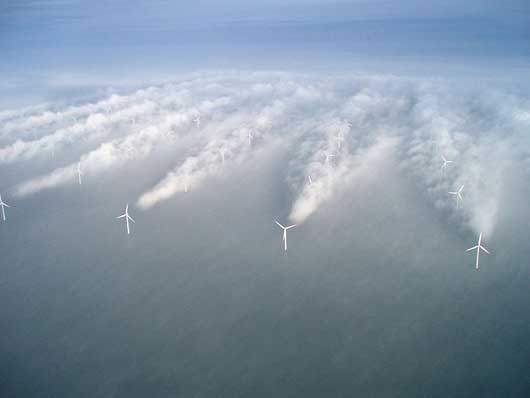By TIM FAULKNER/ecoRI News staff
 As new offshore wind
farms are built off the Northeast coast, a new report suggests that the current
models of wind turbines may not withstand the most powerful of hurricanes.
As new offshore wind
farms are built off the Northeast coast, a new report suggests that the current
models of wind turbines may not withstand the most powerful of hurricanes. The study, by the University of Colorado Boulder, the National Center for Atmospheric Research and the U.S. Department of Energy, is intended to help the budding offshore wind industry as it expands into hurricane-prone regions, such as the East Coast.
“We wanted to understand
the worst-case scenario for offshore wind turbines, and for hurricanes, that’s
a Category 5,” said Rochelle Worsnop, lead author and a graduate researcher in
the University of Colorado's Department of Atmospheric and
Oceanic Sciences (ATOC).
Current design standards
require offshore wind turbines be built to withstand 112-mph winds. Using
computer-generated simulations, researchers found that portions of Category 5
hurricanes can reach up to 200 mph. Turbine blades also can be stressed by
sudden and powerful shifts in wind direction, called veer.
Offshore wind turbines are typically larger than land-based turbines because components can be shipped over water instead of along size-restrictive railways and roads. The structures are therefore exposed to greater harm over their 20- to 30-year life, according to the report.
“Success could mean
either building turbines that can survive these extreme conditions, or by
understanding the overall risk so that risks can be mitigated, perhaps with
financial instruments like insurance,” said Julie Lundquist, a co-author of the
study and a professor at ATOC and the Renewable
and Sustainable Energy Institute.
A subsequent study by
the same group will look at the long-term effects of hurricanes on offshore
wind farms built off the Atlantic Coast.
Rhode Island holds the
honor of building the country’s first offshore wind farm, with the completion
of the Block Island Wind Farm last November. The developer of the five-turbine,
30-megawatt wind farm, Providence-based Deepwater Wind, says the University of
Colorado study is more relevant to the Southeast, where hurricane are more
common and more powerful.
“Current offshore wind
turbine designs are suitable for the wind conditions expected in the Northeast,
where the strongest hurricane to make landfall in recorded history was a
Category 3," Deepwater Wind spokeswoman Meaghan Wims said.
The most recent Category
3 hurricane to make landfall in New England was Hurricane Carol in 1954. The
storm had a sustained wind of 110 mph.
Deepwater Wind designs
its turbines to withstand a 100-year storm, which has top wind speeds of 134
mph.
In the coming the
decades, the company is planning to erect wind farms in the waters between
Maryland and Maine.
“We don’t expect
offshore wind energy to be deployed in the Southeast in the near term for other
reasons — namely, a lower offshore wind resource than the Northeast,” Wims
said.
Deepwater Wind and other
developers have proposed multiple projects off of the wind-rich Northeast
coast. Deepwater Wind is advancing a 15-turbine project, called South Fork Wind Farm, off eastern Long Island.
Its Deepwater ONE project is slated for
thousands of acres of federal waters between Massachusetts and Rhode Island.
Vineyard Wind and DONG Energy, both based in Denmark, are also planning
projects in the region. Bay State Wind, owned by DONG and Eversource Energy,
intends to build several wind farms in the region.
But it’s only a matter
of time before these wind turbines are tested by hurricanes. A report by the Union
of Concerned Scientists says climate change, and warming oceans in particular,
are making coastal storms more intense.
Since the 1970s, the
number of Category 4 and 5 hurricanes has almost doubled. Category 5 hurricanes
have winds exceeding 157 mph; Category 4 winds blow between 130 and 156 mph;
Category 3 winds are between 111 and 129 mph.